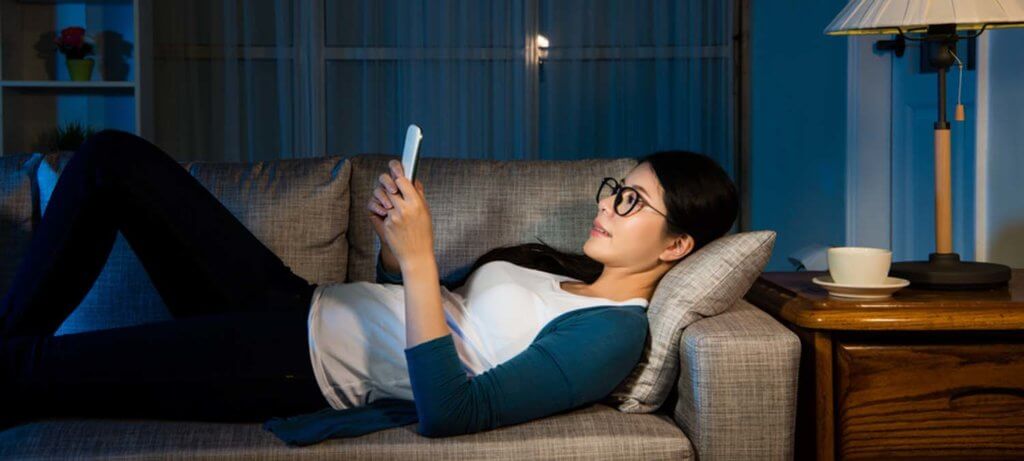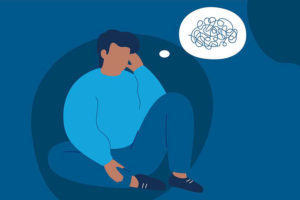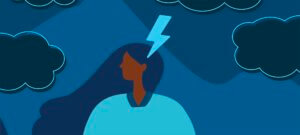When most people think about migraine treatment, they think of medications. Although medications are often an important part of treatment, behavioral interventions – like biofeedback and relaxation – are very effective tools for people with migraine as well. And you don’t have to choose between them; you can participate in behavioral therapies at the same time as medications, or on their own.
Another proven treatment for migraine prevention is cognitive behavioral therapy, which helps people with migraine reduce both how often they’re getting migraine attacks as well as the associated disability (how much they’re interfering with your life). Using cognitive behavioral therapy for migraine can help you replace unhealthy thinking patterns and unhealthy behaviors with more helpful strategies to improve life with migraine.
What is cognitive behavioral therapy?
Cognitive behavioral therapy, or CBT, is a type of psychotherapy that helps people evaluate their thoughts and behaviors, and change them when necessary. The basic premise behind CBT is a relatively simple one: our feelings, thoughts, and behaviors are all interconnected – and they all affect the experience of life with migraine.
One of the main principles of CBT is that the way we perceive the world and think about the events in our lives has a big effect on how we feel, both physically and emotionally. By changing the way we think about things, we can change the way we feel.
The way we perceive the world and think about the events in our lives has a big effect on how we feel, both physically and emotionally.
When CBT was first created (by Dr. Aaron Beck in the 1960s), it was mostly used to help people with anxiety and depression. Since then, it’s been successfully used for a wide range of physical health problems as well, from chronic pain conditions to sleep disorders to weight loss.

CBT and thought patterns
One way that CBT works is by changing people’s thinking patterns. For example, people who have depression often feel sad. They may feel helpless and hopeless in their lives.
CBT experts help people with depression identify and change the thought patterns that contribute to these feelings of sadness. By helping them identify and change their thoughts, CBT therapists help people feel better, too.
For example, someone with depression might have the recurring thought, “I don’t have any friends anymore. No one wants to be around me.” Obviously, this thought is bound to make anyone feel depressed and lonely.
CBT could help this person realize that not only is this thought damaging to them, but it’s also probably not 100% true. A CBT therapist might help this person examine this thought and replace it with a healthier one, like “I haven’t been as close with my friends lately. I haven’t felt like doing things and have canceled plans, and some people may hold that against me. But I still have some friends who care about me.”
CBT and behaviors
Another way CBT works is through changing behaviors.
For example, a person with depression might work on getting outside for a walk. Their depression might stop them from feeling motivated to leave the house, but in fact, the more they get outside and get moving, the less severe the depression symptoms will be. This would lead to a positive, upward cycle in which the person is feeling better and better over time.
A CBT therapist can also teach coping skills for managing life’s difficulties. Taking the same example of depression, a CBT therapist might teach techniques for self-soothing when someone is going through a depressive episode or a tough time. For example, they might teach a patient how to reach out to loved ones or practice self-care.

Cognitive behavioral therapy treatment for migraine
It has been scientifically proven that CBT can help reduce the frequency of migraine attacks for people with migraine. CBT can also help you cope with the migraine attacks that you do have, so that migraine is less debilitating in your life.
What is CBT for migraine?
CBT for migraine is a little bit different than traditional CBT for mental health issues. It’s tailored to the thoughts and feelings that are common with migraine, and focuses on the key thinking and behavior changes that lead to improvement.
But the basis is the same: by changing the way you think and act, you can change the way you feel. This is true for both painful emotions and physical pain. In addition, CBT for migraine helps people make healthy lifestyle and behavior changes, which can have a big positive impact on migraine.
By changing the way you think and act, you can change the way you feel.
Just like CBT for other conditions, cognitive-behavioral therapy for migraine uses two main strategies to help people experience fewer migraine attacks and less disability:
- CBT for migraine helps people challenge their irrational and negative thoughts about migraine that may lead to more stress and disability.
- CBT for migraine helps people adopt healthy behaviors and lifestyle changes that are scientifically proven to reduce migraine activity.
Through these two avenues, CBT helps people with migraine experience fewer headache days and migraine attacks, and reduces disability associated with migraine attacks. It also helps people feel better in general and helps them feel that they, not migraine, are in control of their lives.

Does CBT for migraine prevention work?
Science has proven that CBT is an effective treatment for migraine prevention. Research has found that CBT alone can help reduce headache activity by up to 60% for people with migraine.
CBT both reduces the frequency of migraine attacks and decreases the amount of disability caused by migraine. In other words, CBT can help you lead a whole, fulfilling, and active life despite having migraine.
One literature review found that relaxation techniques combined with CBT intervention is more effective for reducing headache attacks than relaxation alone. On top of that, some studies suggested that there’s no statistical difference between clinic-based CBT and self-help CBT programs. That means that you can use CBT techniques – like the ones included in the Juva app – to help yourself at home.
CBT is also endorsed by scientific organizations as an effective treatment for depression, anxiety, and stress management. Changes in stress level is one of the most commonly reported migraine attack triggers. CBT can help people with migraine manage their stress levels in healthy ways. Changes in stress (in either direction, more or less!) are associated with an increased risk of a migraine attack, so keeping a handle on the stress that you feel is really valuable. Of course, we can’t always control the things that happen to us, but we can control how we respond to them. That is another thing that CBT focuses on.
On top of this, people with migraine are more likely to have depression and anxiety. There are many potential reasons for this. There may be a genetic predisposition to migraine, depression, and anxiety, meaning that something in your genes or nervous system lends itself to all of these conditions. They all share some of the same neurotransmitters (or chemicals) in the brain, and they may be affected by some of the same life events. It also makes sense that living with migraine could create a lot of extra stress in people’s lives, and life with chronic pain can fuel feelings of depression. CBT can address symptoms of depression and anxiety along with helping people manage their migraine.
Cognitive-behavioral therapy for migraine has also been found to be helpful for children and teens who have migraine. This is great news, because young people don’t typically have access to the same types of treatments (like certain medications) that adults do.
The data show and many experts agree that for some people, the most effective treatment for migraine is a two-pronged approach: CBT (along with other behavioral strategies like relaxation and biofeedback) and appropriate medications. However, the decision whether or not to take medication is a personal one, and CBT offers an alternative or complementary drug-free treatment option for those who want it.

What are some common CBT techniques for migraine management?
Again, CBT for migraine works primarily in two ways: by helping people challenge their negative thoughts about the migraine experience, and by encouraging them to practice regular healthy lifestyle habits.
Changing irrational thoughts
Of course, migraine attacks can be physically painful and have other debilitating symptoms like nausea and extreme sensitivity to light and sound – there’s no doubt about that. But CBT proposes that in addition, the way we think about migraine can make the experience even worse. Our negative thoughts about migraine can also lead us to make decisions that make it more likely for a migraine attack to continue or get worse.
For example, let’s say that you wake up with a migraine attack on a workday. You have so much pain, nausea, and sensitivity to light that you have to call out sick. What goes through your mind?
For many people with migraine, it might be something like, “Oh no. This is the third time I’ve had to call out because of migraine. What will they think of me? I’m letting all of my coworkers down. My boss probably thinks I’m unreliable. Maybe I’ll even get fired. What am I going to do?”
Does that sound familiar? We call this pattern of thinking “catastrophizing.”
Thoughts may be “just in your head,” but they often have real-life consequences. Usually, our thoughts have a heavy influence on how we feel and how we act.
If you had a thought like the one above, that may cause you to feel terrible about yourself. You might feel inadequate, and your stress levels would be sky-high if you’re worried you’d lose your job. You might worry about your professional reputation all day long, and become locked in a downward spiral of anxiety.
Because of this, your distress and pain may get worse. And if your stress interferes with things like restful sleep or healthy eating habits, then you might put yourself at even greater risk for more attacks.
When looking at it this way, it’s easy to see how CBT can help. What would happen if you challenged these negative thoughts instead? What if you replaced them with something more realistic and helpful, like “It isn’t my fault that I have migraine, and I’m doing the best I can. I’m a good employee, and work hard when I’m not having a migraine attack. I do my best to take care of my responsibilities at work and that’s the best that I can do. I can’t control other people’s opinions of me.”
What would happen then? In this scenario, you might use the day to get the rest and sleep that you need. You might take advantage of the time off to practice self-care and make healthy choices. Because of these choices, you’d probably be more likely to be feeling well enough to return to work the next day.
This is the power of CBT. By noticing and changing the irrational thinking patterns that make you feel worse, you can start to limit the amount of distress that migraine brings to your life.

Changing lifestyle habits
CBT for migraine also helps people change behaviors that may make it more likely for them to have more frequent attacks.
This may include relaxation strategies. Although relaxation is usually considered a separate intervention, a CBT therapist may work with you to make sure you’re incorporating relaxation strategies into your daily schedule.
Other behaviors that a CBT therapist may work with you on changing include your sleeping habits, eating habits, hydration, exercise, stress management, and managing personal migraine triggers you may have.
CBT for migraine also works on teaching and strengthening stress management techniques. In addition to relaxation strategies, these might also include things like problem-solving or assertive communication skills.
Being equipped with these types of coping skills make it less likely that you’ll experience any intense spikes followed by drops in your stress levels – which for many people can be a trigger for a migraine attack. Remember, when it comes to managing migraine, consistency is key.

Try cognitive behavioral therapy for migraine with Juva Health
You can get access to at-home CBT and biofeedback for migraine with Juva Health. Juva’s innovative app uses your phone’s technology to measure your biometrics (like heart rate) while guiding you through evidence-based cognitive and behavioral strategies for migraine management. You’ll also get access to self-guided CBT lessons that can help you learn how to manage the distress and disability that often come along with life with migraine.
Sign up for a FREE year of Juva Health today.



